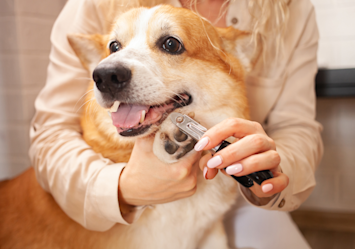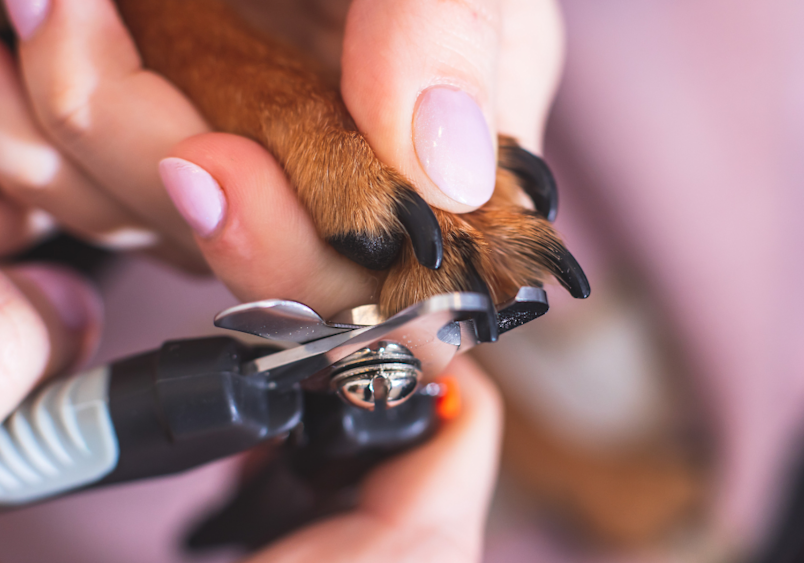
When you own a dog, they become a beloved member of your family. Ensuring their health and happiness is your top priority, and nail trimming is an essential part of their grooming. While nail trimming can seem daunting at first, trimming your dog’s nails is crucial for their comfort and overall wellbeing. If you’re new to trimming your dog’s nails, this guide will help you approach this task with confidence and care.
Understanding the Need for Trimming Dog Nails
If you can hear the click-clack of your dog’s nails on the floors, or notice their nails curving, these are both signs that their nails are too long. Nails that are too long can even cause your dog to walk awkwardly to avoid discomfort. All of these are indicators that it’s time to trim your dog’s nails.
Long nails can lead to a variety of health problems for your pup. Overgrown nails can be painful for your dog. When they get too long, they can even alter your dog’s posture and gait, which can put unnecessary stress on their legs and spine. Longer nails are also at risk of splitting, and a broken dog nail can cause an infection. Regular nail trims help to prevent all these issues, keeping your dog happy and healthy.
How Often Should You Trim Your Dog’s Nails?
A good rule of thumb is to check your dog’s nails every 1-2 weeks. However, the need to actually trim them can vary based on several factors. If you have another routine in place to manage your dog’s wellbeing, like a schedule to clean your dog’s teeth, you can add in checking their nail length. This will help it become a routine habit and task which will help ensure their nails don’t grow too long.
Your dog’s breed, weight, and exercise habits all play a role in how often their nails need trimming. Smaller breeds often need more frequent trims, while larger breeds might need them less often. Dogs that get regular outdoor exercise on rough surfaces may naturally wear down their nails, needing fewer trims. On the other hand, indoor or less active dogs might need more frequent attention to their nails.
Tools and Supplies for Trimming Dog Nails
These are various tools available. Choosing the right one can make you feel more confident and make the process smoother for both you and your dog. Here are the most common types:
Scissors-style trimmers: These resemble regular scissors and are great for larger, thicker nails.
Guillotine-style trimmers: These have a hole where you place the nail, and a blade cuts through it when you squeeze the handle. They work well for smaller nails.
Grinders: These use a rotating file to gradually wear down the nail. While they take more time, they can be less stressful for dogs if introduced properly.
Remember to be patient with yourself. Like any skill, learning how to cut dog nails can take some time and practice to become completely comfortable and confident.
Even if you go slow and are careful, accidents can still happen. If you cut the quick of the nail – the sensitive area inside the nail – it can bleed and cause pain. Havin styptic powder or clotting powder on hand can quickly stop the bleeding and provide relief for your dog.
Preparing Your Dog for Nail Trimming
Before you start dog nail trimming, it’s essential to get your dog used to having their paws touched. To start off, you can gently handle your dog’s paws regularly, offering treats and praise to create positive associations. Once your dog is comfortable having their paws touched, you can move on to introducing the nail trimmers. Remember to use an extra tasty, high value treat like cheese or freeze-dried liver. In my experience working at a veterinary hospital, many dogs dislike having their feet handled, and using an extra tasty and special treat is going to help them feel more comfortable, rather than using something like their kibble.
To introduce the nail trimmers, start off by showing the nail trimmers (or grinder, if you choose to use that) to your dog and let them sniff it. Reward your dog with a treat for being comfortable near the trimmers or grinder. If you are using a grinder, turn it on so your dog can get used to that sound and reward them for being calm around it. When your dog is comfortable with the trimmers or grinder, you can create a comfortable environment.
Even though it’s an easy process, nail trimming can still be stressful for some dogs. Choose a comfortable, quiet spot where your dog can relax to create a calming environment for nail trimming. If there is someone else in your household to help, it can be useful to have them hold your dog and reward them with treats to make the process smoother.

Step-by-Step Guide on How to Cut Dog Nails
If you’ve never trimmed your dog’s nails, rest assured that these step-by-step instructions will help you feel more confident and knowledgeable.
Gather all the necessary supplies. Make sure you have your chosen nail trimmer, styptic powder, and treats.
Ease your dog into the process. Remember to remain calm and talk to your dog in a soothing voice. Offer your dog treats frequently so they can remain calm and create a positive association.
Pick up the foot and isolate the nail to cut. Hold your dog’s paw gently but firmly, isolating the nail you’re going to trim.
Decide where to cut the nail while avoiding the quick. The quick is the pink or white, sensitive part of the nail in the center that contains blood vessels and nerves. With light-colored nails, you can actually see the quick inside. For dark nails, cut small pieces at a time to avoid cutting too much; once you start to get close to the quick, you’ll see a lighter, white spot in the center.
Cut the nail at a 45-degree angle. Position the trimmer and cut the nail at a 45-degree angle. This will help prevent splitting and create a cleaner cut.
Don’t forget the dewclaws. Dewclaws are the nails located higher up on the paw. Since they don’t touch the ground, they can easily become overgrown, so remember to trim them as well.
Nail grinding can either be an alternative or additional step. You can use grinders instead of trimmers to take length off your dog’s nails. If you prefer, you can also use a nail grinder as the last step in nail trimming to smooth the edges of the nails. This can prevent snagging and make the nails less sharp.
Reward your dog for a successful trimming session. Always finish your nail trimming sessions with praise and treats. Positive reinforcement helps your dog associate nail trimming with good experiences.
Tips for Handling Potential Issues During Nail Trimming
If you accidentally cut the quick, don’t panic. Apply styptic powder to stop the bleeding and soothe your dog. Give them a break and plenty of reassurance before continuing. If your dog seems unsure, consider stopping the session altogether and trying another day.
While dog nail trimming is generally painless for your dog, some dogs are overly sensitive with their feet and become anxious and uncooperative. If your dog is struggling or showing signs of anxiety, take it slow. You might only trim one or two nails at a time initially, and that’s normal. Use plenty of treats and praise to try to help your dog feel more comfortable.
In some cases, it’s best to opt for a professional to trim your dog’s nails, so consult your veterinarian or a professional groomer for advice.
Professional Grooming and Trimming Options
If you’re uncomfortable trimming your dog’s nails or if they’re anxious and uncooperative, professional groomers are a great option. The cost is usually reasonable, and the benefits include expert handling and reduced stress for you and your dog. Most professionals charge between $20-$40 for a nail trim.
In some very severe cases, dogs may have such bad anxiety with nail trimming that you can barely touch their feet. If this is the case, consult your veterinarian. Veterinarians can prescribe medications before trimming your dog’s nails to help them overcome their fear. Enrolling your pup in a dog wellness plan can help you budget for these extra, predictable expenses to keep your pet healthy without worrying about the financial aspect. Many pet insurance plans offer these optional, non-insurance plans as an add-on to insurance.
Even something as seemingly simple as nail trims can highlight the value of pet insurance. Overgrown nails can cause discomfort and even affect your dog's gait, potentially leading to long-term health problems. If left untreated, these issues might require a vet visit for pain medication or corrective procedures.
Embrace dog insurance offers financial protection for these unexpected scenarios, and even some that might arise during routine care. Accidental nicks to the quick, the sensitive area inside the nail, can happen during nail trimming. While styptic powder can usually stop minor bleeding, sometimes a vet visit is necessary if the bleeding is excessive or won't stop.
With customizable Embrace Pet Insurance plans, you can find coverage that fits your budget and gives you peace of mind knowing you're prepared for unforeseen costs.
Now You Can Clip a Dog’s Nails
Regular nail trims are a small act of love that can have a big impact on your dog's life. Not only does it prevent painful overgrowth and potential health issues, but it also creates a special bonding moment between you and your furry companion. With the right tools, techniques, and a little patience, dog nail trimming can become a cherished part of your routine, a quiet act of love that strengthens the unique connection you share with your furry best friend.